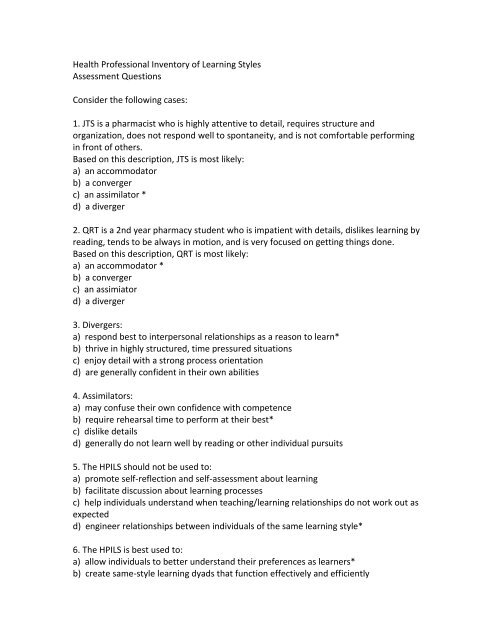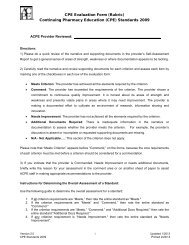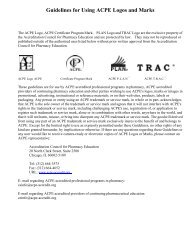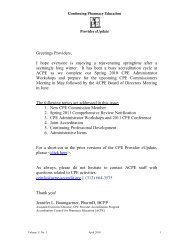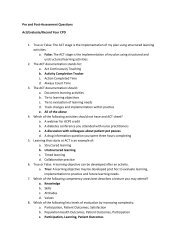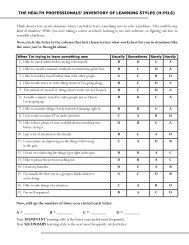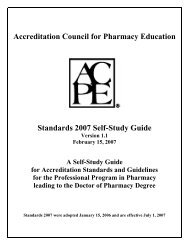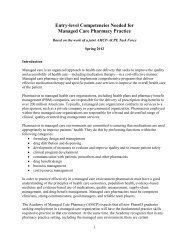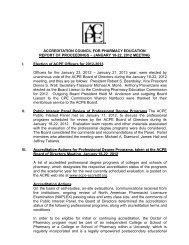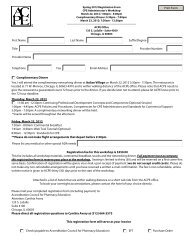Health Professional Inventory of Learning Styles
Health Professional Inventory of Learning Styles
Health Professional Inventory of Learning Styles
You also want an ePaper? Increase the reach of your titles
YUMPU automatically turns print PDFs into web optimized ePapers that Google loves.
<strong>Health</strong> <strong>Pr<strong>of</strong>essional</strong> <strong>Inventory</strong> <strong>of</strong> <strong>Learning</strong> <strong>Styles</strong>Assessment QuestionsConsider the following cases:1. JTS is a pharmacist who is highly attentive to detail, requires structure andorganization, does not respond well to spontaneity, and is not comfortable performingin front <strong>of</strong> others.Based on this description, JTS is most likely:a) an accommodatorb) a convergerc) an assimilator *d) a diverger2. QRT is a 2nd year pharmacy student who is impatient with details, dislikes learning byreading, tends to be always in motion, and is very focused on getting things done.Based on this description, QRT is most likely:a) an accommodator *b) a convergerc) an assimiatord) a diverger3. Divergers:a) respond best to interpersonal relationships as a reason to learn*b) thrive in highly structured, time pressured situationsc) enjoy detail with a strong process orientationd) are generally confident in their own abilities4. Assimilators:a) may confuse their own confidence with competenceb) require rehearsal time to perform at their best*c) dislike detailsd) generally do not learn well by reading or other individual pursuits5. The HPILS should not be used to:a) promote self-reflection and self-assessment about learningb) facilitate discussion about learning processesc) help individuals understand when teaching/learning relationships do not work out asexpectedd) engineer relationships between individuals <strong>of</strong> the same learning style*6. The HPILS is best used to:a) allow individuals to better understand their preferences as learners*b) create same-style learning dyads that function effectively and efficiently
c) direct individuals towards roles and positions best suited for their temperamentd) as a managerial tool to create well-functioning work teams7. When undertaken as part <strong>of</strong> a CPD process, self-reflection should be:a) based on external criteriab) continuous*c) validated by experts to ensure its accuracyd) focused on specific tasks only to ensure precision8. Convergers:a) may confuse their own confidence for competence*b) enjoy theory and theoretical discussions without the need for real world applicabilityc) are highly sensitive to feedback and require a large amount <strong>of</strong> positive reinforcementd) generally learn best by reading9. Accommodators:a) enjoy detailsb) have a strong process orientation with a need to follow structures and routinesc) may sacrifice quality for time-efficiency*d) tend to require a great deal <strong>of</strong> rehearsal time prior to performing in public10. You have just completed the HPILS. Based on your self-assessment, you should:a) identify the types <strong>of</strong> learning resources that match your learning style*b) consider changing your career path in light <strong>of</strong> the results, to better match yourlearning style to your career aspirationsc) complete the HPILS again within 2-4 weeks to ensure test-retest reliabilityd) use the results to guide your decisions related to who you will work with


